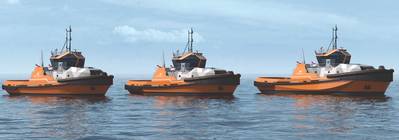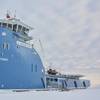Growing interest in hybrid-electric power systems is expanding the search for new propulsion and energy-storage systems in the workboat sector, where compliance with emerging environmental regulations and a relentless pursuit of operational efficiency are driving change.
To meet demands for cleaner more efficient power, owners are examining the potential for less conventional methods of energy generation and storage – such as fuel cells, lithium-ion batteries, super-capacitors, flywheels, wind and solar – to propel their vessels. In the workboat sector, where quick energy delivery is commonly required during peak-loading conditions by everything from tugs to offshore support vessels, the combination of lithium ion batteries and super-capacitors is gaining market traction. In fact, the hybrid partnership is becoming big news.
Electric-hybrid propulsion systems are not new to shipping; the passenger ship sector has been applying diesel-electric propulsion for decades. But recent advances in hybrid-electric power and energy storage technologies are bringing additional benefits. In examining those benefits, it is first important to differentiate between hybrid propulsion and a hybrid power system – two concepts that are often confused.
Defining Principles
Hybrid propulsion usually utilizes internal combustion engines and electric generators to supply power to the propulsion shaft and thrusters, as referenced in the passenger-ship sector. Hybrid power denotes at least two different types of electricity generating equipment (i.e., diesel generators) or storage (lithium batteries) to provide power for propulsion and hotel loads (which includes onboard climate control, communication, entertainment, lighting, refrigeration, etc.) demands.
Hybrid propulsion systems are already widely used in the marine industry, such as onboard offshore support vessel and harbor tugs. To date, the North Sea area has been the focal point of this activity, driven by government-led environmental mandates and restrictions. Many OSVs serving this area have been retrofitted or built with hybrid systems. Hybrid power, on the other hand, is starting to impact vessel-system designs, and the technologies for the associated energy-storage and management systems are fast evolving. Hence, industry standards for these novel technologies have yet to be established.
Realizing Potential Benefits
Many of the potential benefits of hybrid power remain theoretical as the technology is still young in the workboat arena, but the new distribution systems could improve on the advantages that hybrid power has over conventional power systems, including better energy efficiency, reduced emissions, dynamic performance and noise elimination.
For example, when an OSV is in normal operations, a hybrid power system could reduce the minimum number of diesel generators that are required to run constantly. This is possible because the energy storage systems ([ESS], i.e., lithium batteries or super-capacitors) can provide the added power for the occasional peak demand caused by shifting currents or waves.
When they operate in harsher environments or more demanding operational routines, multiple generators could run at a constant speed and the ESS supports the electrical distribution system with extra power to relieve the stress of added load demands, such as with dynamic positioning. Engine maintenance, fuel consumption and carbon-related emissions could be greatly reduced. The fast-reacting ESS acts as an energy buffer for the comparably slow-starting generators to improve electrical power response time and to help improve the safety and reliability of the vessel.
As the technology behind hybrid power is new to the industry, ABS recently published several documents to expand industry understanding about the associated safety practices, as well as the benefits and risks of adoption. These include:
- An Advisory on Hybrid Electric Power Systems
- A Guide for Use of Lithium Batteries in the Marine in Offshore Industries
- A Guide for Use of Supercapacitors in the Marine and Offshore Industries
The Supercapacitor Guide, the most recently published, is helping to establish safety guidelines for any owners, operators, shipyards, designers and manufacturers involved in the production or use of these new technologies. The maritime industry is increasingly interested in using supercapacitors as an energy-storage solution when quick delivery of energy is required during a peak loading conditions, such as when OSVs use power thrusters for dynamic positioning while station-keeping.
Other diverse examples of how they and other energy storage systems could enhance operations include:
When used for load leveling or peak-shaving, supercapacitors act as an energy buffer to supply or absorb power, allowing generators to be operated at a near constant load. Their ability to optimize power loading and reduce running hours can reduce maintenance requirements. With optimal loading, a higher average load can be maintained, resulting in a more stable and efficient operation of the prime movers.
The supercapacitor-battery partnership could be used as additional power sources when generators shut down. In some instances, they can be used for blackout prevention, fault ride-through and assist in blackout recovery. They may be also used as part of an emergency power source for essential and emergency services.
Dynamic Positioning Vessels. Supercapacitors could be used to supply thrusters and act as a spinning reserve in dynamic-positioning mode and/or as standby power for fault ride-through on DPS-2 or -3 vessels operating in closed bus.
Heave Compensation. On Mobile Offshore Drilling Units or OSVs supercapacitors could be used as a buffer for heave compensation equipment and to harvest regenerative power from cranes.
Renewable Energy Storage. Supercapacitors may be used as an energy-storage device on vessels or offshore installations with cyclic renewable energy sources to stabilize the fluctuating power flow connected to the shipboard electrical distribution system.
They can also be installed in combination with batteries to potentially protect the batteries from extreme peak loads, extending battery life and achieving both high-power and high-energy density.
Low Temperature Environment Usage. Supercapacitors can be used in the low temperature environments that significantly constrain battery performance.
Clearly, supercapacitors have great versatility and potential to enhance operations. They also have the low internal resistance that makes higher currents possible, compared to the capabilities of battery applications. Charging and discharging a battery involves a temperature-dependent electro-chemical reaction between the electrodes and the electrolyte. An Electric Double Layer Capacitor distinguishes itself from a battery – in that the charging and discharging process does not involve a chemical reaction and is largely independent of temperature.
Looking Ahead
While the early interest and application of hybrid power systems has come from OSV and tug owners, technically, there is no limit to the size of vessel that could be powered by a combined supercapacitor-battery ESS. River, inland and portside operations have similar opportunities for hybrid development.
For example, both lithium ion batteries and supercapacitors are scalable, allowing the owner to expand from cell, to module, to pack, iteratively increasing the storage capacity as required. Numerous side-by-side batteries could be run by a power-management system, which has sub-sets for capacitor management and battery management.
Any supercapacitor or battery will have its own management system for safety requirements, which would run in accordance with its design. This would interact with the vessel’s power-management systems. The scalability of the systems could make them appropriate for a drillship, a small ferry, and many other applications. It all depends on what size ESS the owner wants to put onboard.
Because ABS sees the potential for energy-storage systems to improve the electric and propulsion systems for a range of vessels, we have been helping industry to engage with the hybrid technology by participating in a variety of workshops and conferences. Beyond the development of a series of hybrid propulsion and power guides and advisories, ABS has also completed several technology-focused, Approval-In-Principle projects and our type-approval program has included several marine battery suppliers.
At present, most of the hybrid work ABS is seeing is related to retrofitting, activities undertaken to improve the operating efficiency of existing ships. But when the industry starts designing and building new ships and systems with energy storage, instead of retrofitting out inefficiency, it may be possible to discover that a ship needs fewer installed generators. Then, lower capital expenses could be coupled with opportunities for lower operating expenses.
The Author
Domenic Carlucci is the ABS Manager for Machinery, Electrical and Controls Technology. Since joining ABS in 2008 Carlucci has held several senior roles in asset integrity management, life cycle risk and reliability, design and plan review, and product and service development. He served in the U.S. Navy as a Nuclear trained Surface Warfare Officer. He received his Bachelors of Science in Mechanical Engineering from Duke University and a Master’s in Business Administration from the University of Houston.
(As published in the January 2018 edition of
Marine News)











